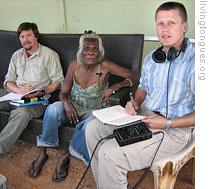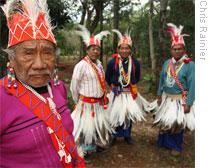2009-12-1
VOICE ONE:
I'm Steve Ember.
VOICE TWO:
And I'm Barbara Klein with EXPLORATIONS in VOA Special English. Today, we travel far and wide to learn about some of the rarest languages in the world. Experts say over half of the world's seven thousand languages are in danger of disappearing. Every two weeks one language disappears.
As the last speakers of a language die off, the valuable information contained within a language also disappears. Join us as we learn about the cultural value of language and why endangered languages must be protected.
(MUSIC)
VOICE ONE:
 |
| Greg Anderson, left, and David Harrison with Patricia Ahchoo, one of the last speakers of both Bardi and Jawi in Australia |
VOICE TWO:
Sometimes a language disappears immediately when the last person speaking it dies. Or, a local language might disappear more slowly. This happens when an official language is used more often and children stop learning the local language of their parents. This is not a new process. Official languages often represent a form of control over a group of people.
Throughout history, the language spoken by a powerful group spreads across a civilization. The more powerful culture rarely respects the language and culture of smaller ethnic groups. So, smaller cultures lose their local language as the language of the culture in power becomes the stronger influence.
VOICE ONE:
For example, many native languages in the Russian area of Siberia are threatened. This is largely because of the hostile language policies of the former Soviet Union that forced the use of Russian as the official language.
The Internet could be thought of as a new method of language control. The United Nations cultural organization, UNESCO, says that ninety percent of the world's languages are not represented on the Internet.
(MUSIC)
VOICE TWO:
Experts say protecting languages is very important for many reasons. Languages contain the histories, ideas and knowledge of a culture. Languages also contain valuable information about local medicines, plants and animals.
David Harrison and Gregory Anderson of Living Tongues say that many endangered languages are spoken by native cultures in close contact with the natural world. Their ancient languages contain a great deal of information about environmental systems and species of plants and animals that are unknown to scientists.
VOICE ONE:
Each language also shows how a culture organizes information. For example, one word in the native language Carrier spoken in British Colombia means "he gives me an object like the fruit blueberries." In the Nivkh language of Siberia, each number can be said twenty-six different ways based on the object being counted. And, in one language in Botswana, there are three main kinds of plants and animals: edible "eat-things", harmful "bite-things" and "useless things."
Here Gregory Anderson talks about why languages are important:
GREGORY ANDERSON: "Language is in many ways, a window to the mind. What these languages contain are all kinds of ways that we structure the world. Language is a way of storing the history of a people. Languages reflect a different historical contact with other groups, for example, in the form of loan words that get borrowed from one language into another. And, for people that have no written history, language can be one of the ways that that history can be gotten at just by looking carefully at the different layers in the language."
(MUSIC)
VOICE TWO:
The Living Tongues group has partnered with National Geographic to create the Enduring Voices Project. The goal of the project is to increase public attention about endangered languages and to study and document them. The project also works to prevent languages from dying out by identifying the most threatened areas where languages are disappearing. These "hotspot" areas include Northern Australia, Central South America, Eastern Siberia and parts of the United States and Canada.
VOICE ONE:
 |
| Speakers of the Maka language in Paraguay |
VOICE TWO:
Many languages are also disappearing from the northwestern part of the United States. The languages spoken by native tribes are increasingly endangered as younger generations learn and speak English. One of the most endangered languages is called Siletz Dee-ni. It was spoken on the Siletz reservation, where the tribe lives on a protected area of land within the state of Oregon. The reservation was created in the nineteenth century to hold people from twenty-seven different native groups.
The groups spoke different languages, so they developed Chinook Jargon to communicate with each other. With increased use of Chinook Jargon and English, the number of people speaking their native languages decreased.
VOICE ONE:
Today, only one person on the reservation speaks Siletz Dee-ni, but others are learning. Living Tongues has helped the tribal members create a Siletz Dictionary to preserve knowledge of this language. Here is a recording of several words in the dictionary.
(SOUND)
VOICE TWO:
Here is an example of the secret mixed language of Kallawaya, spoken by male traditional healers in a small community in southern Bolivia.
(SOUND)
 |
| Don Max Chura, a Kallawaya language consultant, with linguist Greg Anderson |
Traditional healers spoke the language at least as early as the fifteenth century during the height of the Inca civilization. Why is it a secret language? Kallawaya is passed down within families from father to son as a way of protecting the special knowledge of healers.
(MUSIC)
VOICE ONE:
Experts say bringing back threatened languages is not easy, but it is very important work. One example takes place in the American state of Hawaii. The United States first claimed Hawaii as a territory in eighteen ninety-eight. Two years before, the use of the Hawaiian language was banned in private and public schools. English became the official language of Hawaii. Slowly, fewer and fewer young natives learned to speak Hawaiian fluently. The language began to disappear.
William Wilson teaches at the University of Hawaii. He says that in nineteen eighty-six fewer than fifty children in Hawaii could speak their native language fluently. That same year, the language ban was lifted after extended protests by native groups. The Hawaiian language began to be taught again in schools. Mister Wilson says about two thousand children now speak Hawaiian. He says that more importantly, many families now speak Hawaiian at home.
VOICE TWO:
This past summer, the Voice of America held a discussion among experts called "Endangered Languages: Saving Voices Before They Are Lost." Portland State University language expert Tucker Childs attended the event. Mister Childs is currently working on documenting Bom and Kim, two endangered languages in Sierra Leone. His brother, Bart Childs, is a VOA reporter.
Bart Childs made a series of videos that show Tucker Childs and his research team at work trying to save these endangered African languages. The videos show that any hope for protecting languages can be found in children and their willingness to learn. It is these young people who can keep this form of culture alive for future generations.
(MUSIC)
VOICE ONE:
This program was written and produced by Dana Demange. I'm Steve Ember.
VOICE TWO:
And I'm Barbara Klein. You can learn more about Living Tongues and the Enduring Voices Project and find a link to Bart Childs' videos on our Web site, 51voa.com. Join us again next week for EXPLORATIONS in VOA Special English.